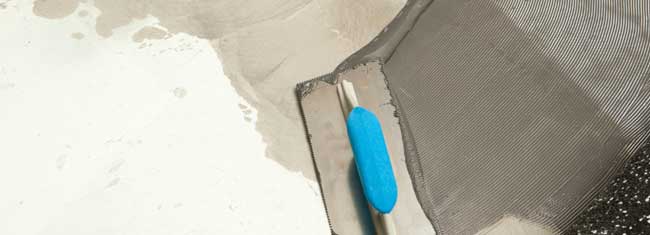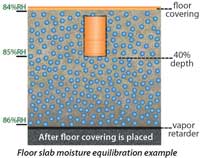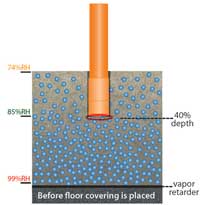More Than Skin Deep: The Beauty of In Situ Relative Humidity Testing
 When monitoring drying concrete slabs, it is important to understand that what you see on the surface is not the entire picture. In any drying concrete slab poured over a vapor barrier, there is a gradient effect to the moisture conditions within that slab – a gradual change from the deepest part of the slab to the surface. On reflection, this makes sense. Water vapor can only evaporate from the surface of the slab and that vapor must first work up through the slab until it reaches the surface. As that surface moisture evaporates, the presence of moisture on the surface lessens making room for more moisture to work up to the surface from the bottom of the slab. So obviously the water vapor level, measured in terms of relative humidity (RH), will be much higher at the bottom or even halfway through the slab than it is at the surface.
When monitoring drying concrete slabs, it is important to understand that what you see on the surface is not the entire picture. In any drying concrete slab poured over a vapor barrier, there is a gradient effect to the moisture conditions within that slab – a gradual change from the deepest part of the slab to the surface. On reflection, this makes sense. Water vapor can only evaporate from the surface of the slab and that vapor must first work up through the slab until it reaches the surface. As that surface moisture evaporates, the presence of moisture on the surface lessens making room for more moisture to work up to the surface from the bottom of the slab. So obviously the water vapor level, measured in terms of relative humidity (RH), will be much higher at the bottom or even halfway through the slab than it is at the surface.
That gradient picture stays in effect until the concrete slab’s surface is sealed with flooring or another surface sealant. After it is covered, the slab’s moisture content will eventually equilibrate over the entire thickness of the concrete slab and present a much more uniform relative humidity. But if the relative humidity is too high within the sealed slab, the likely hood of a flooring failure increases exponentially. Those failures can get ugly in terms of costly warranty claims, costs, repair time and reputation.
Understanding the movement of moisture through a drying concrete slab immediately presents a problem with test methods that only act on the surface of the slab. Calcium chloride testing (also known as moisture vapor emission testing), RH “hood” methods, and concrete moisture meters all measure the surface conditions of the slab but in no way reflect the “inner” picture of moisture conditions under the surface. Pinless surface meters do send a signal to a certain depth of the concrete but can be skewed by the presence of rebar, the size of the aggregate and even the amount of aggregate in the concrete mix. Pin-style meters do not penetrate deeply enough to be completely accurate, and are sensitive to chemical or physical properties of various aggregates that impact the resistance to their electrical signals.
These test methods all have their place as long as you understand that they will give an indication of surface conditions only. They are the “skin deep” test methods for a drying concrete slab. But for a long-term installation situation, they cannot, by design and by function, give an accurate indication of the slab’s moisture condition.
So how, then, do you accurately predict the final relative humidity of a drying concrete slab?
 The best way to see the true moisture conditions in a concrete slab is to use “in situ” relative humidity probes that are placed down into the concrete to measure the moisture conditions. Testing begun in Sweden and adopted by the ASTM has proven that a probe placed at 40% of the slab’s depth will ultimately give the most accurate readings of the final moisture conditions. When the probe is placed within the concrete and sealed from environmental surface conditions, the relative humidity conditions in the slab can be confidently measured and used to schedule flooring installations, track drying conditions and ensure the best possible results for surface applications. The beauty of relative humidity probes is their ability to see beyond the surface of a concrete slab to the true conditions within.
The best way to see the true moisture conditions in a concrete slab is to use “in situ” relative humidity probes that are placed down into the concrete to measure the moisture conditions. Testing begun in Sweden and adopted by the ASTM has proven that a probe placed at 40% of the slab’s depth will ultimately give the most accurate readings of the final moisture conditions. When the probe is placed within the concrete and sealed from environmental surface conditions, the relative humidity conditions in the slab can be confidently measured and used to schedule flooring installations, track drying conditions and ensure the best possible results for surface applications. The beauty of relative humidity probes is their ability to see beyond the surface of a concrete slab to the true conditions within.